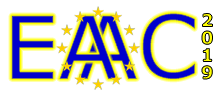Speaker
Description
The advent of ultra short high intensity lasers has paved the way to new and promising, yet challenging, areas of research in the laser-plasma interaction physics. The success of constructing petawatt femtosecond lasers, that helps designing future particle accelerators, intrinsically relies on the combination between experiments and massively parallel simulations. Hitherto, Particle-In-Cell codes have been successful to accurately describe the laser-plasma interaction. Nevertheless, its 3D numerical modelling can be a challenging task and computationally very expensive. This is due to the large dispersion between the scales involved in this process. In order to speed up such simulations significantly, we need to use reduced numerical models. Fourier field decomposition in azimuthal modes for the cylindrical geometry is a promising reduced model especially for physical problems that have close-to-cylindrical symmetry like Laser WakeField Acceleration. This geometry is implemented in the open-source code Smilei.
To investigate its accuracy, we study the impact of different physical and numerical parameters involved in the simulations. The obtained results are benchmarked with a full 3D cartesian description with a realistic laser profil as described by our collaborators from the experimental group of Apollon laser instead of using a gaussian analytical expression.

